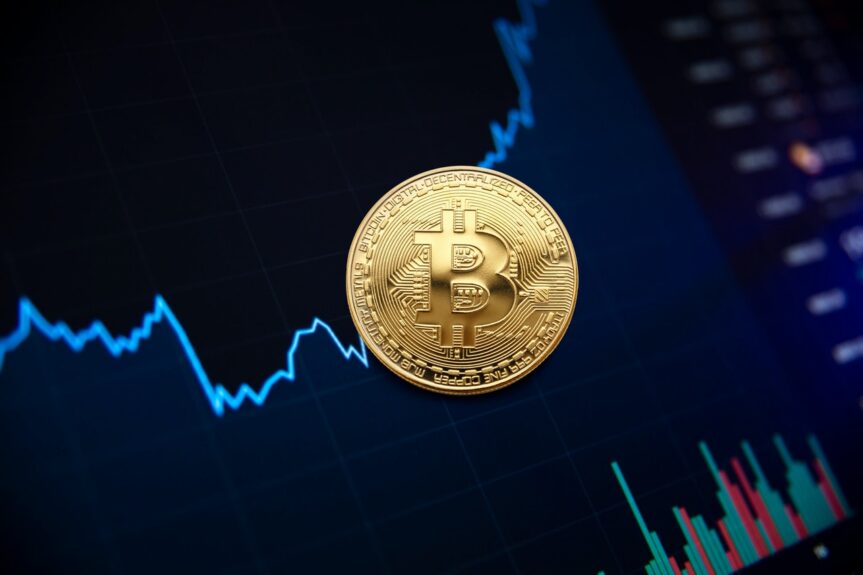
Following the numbers as they rise and fall when investing in cryptocurrency can be a rush. As the arrows point up and down, some trends lead people to make impulsive (sometimes irrational) decisions. Mass buying or selling can create volatile swings, but hasty decisions can derail a long-term crypto-currency investment plan. Thus, it is crucial to have your goals and percentages mapped out.
Profiting from changes in percentages in cryptocurrency requires selling at least part of your digital investment. If your cryptocurrency investment gained 100%, it might be a good time to sell a portion. A good plan involves selling only 5-10% of your overall investment at a time while holding the bulk.
Cryptocurrency can be an avenue to financial freedom. However, the road is bumpy and has sharp turns, so it requires setting out your goals, making a long-term strategy, and sticking with it. Rather than looking at short-term trends, consider the numbers as they relate to your specific plan. These will help you minimize regrets and keep your eye on the future. While advantages can be gained in short-term trading, these too only work if part of a broader strategy.
Investing in cryptocurrency is a long-term investment, but sometimes people want to take advantage of market highs and cash out at least part of their investment. However, taking profit from crypto isn’t the same as collecting interest from a savings account. With Crypto, you can’t take the interest and leave the core investment alone. Instead, you must sell a percentage of your cryptocurrency, either parts of a coin or several coins, to lock in a cash gain.
Selling cryptocurrency for more than you bought it will, in this sense, produce a “profit.” However, without an investment strategy, this leaves the profit sitting around, no longer working to create future wealth or working towards some other goal (i.e., purchasing a home)
When looking to sell crypto in the short term, it is essential to have realistic expectations for profit percentages. While there are stories of people hitting it big by waiting for 100% or even 1000% profit gains, most people don’t have the emotional capacity (or the sheer luck) to achieve these gains in the short term, so many find themselves going from a significant gain, getting greedy, and then ending up at a loss down the line. With long-term investing, the occasional plunge is far from a disaster; it is actually (and usually) a good time to purchase more by Dollar Cost Averaging. But when looking for short-term gains, waiting for the ultimate high is setting yourself up for ultimate lows.
Instead, you could set a profit percentage goal of around 30%. Then, once this threshold is achieved, only sell a small percentage of your cryptocurrency each week, say about 5-10%, when this figure is hit. Then wait a week, and reassess what the market is doing. If the market is still above your 30% goal, you could sell another small amount while protecting the bulk of your cryptocurrency investment. How long you do this depends on your long-term investment plan.
Another factor to consider is when you purchase your cryptocurrency. If you invested at the bottom (during a bear market), you could be sitting on massive profits of 50%, 100%, or even 1,000%. Deciding not to sell at this point, thinking your investment will continue to grow at this rate, is just greed getting the best of you. You need to take profits at this point, at the very least, sell your seed investment (the money you used to invest initially). However, if you invested at the top (during a bull market), the best strategy is to Buy and Hold. Since Bitcoins’ inception, it has gone up in value 90% of the time (3,800 days up out of 4,200 days in total). This means that statistically speaking, people who Buy and Hold will fare much better than people who panic sell or day-trade for short-term gains.
This is why we also recommend that people never exit their entire position. A popular saying goes “time in the market beats timing the market.” This means that the time spent in the market will almost always be a better strategy than trying to time your short-term trades.
At DWG, we encourage investors to HODL (crypto slang for “buy and hold”) when planning for long-term digital wealth. As the saying goes, ‘Longer Pays Better.’ However, when working with clients in discovering new opportunities in the crypto market, it is essential to understand the individual’s goals. By doing this, we can help them strategize their cryptocurrency investment plan.
For example, some individuals want to recoup their seed money after their cryptocurrency investment has reached a certain percentage, say 30%. Once their cryptocurrency hits that 30% profit, they sell a portion of their investment, no more than 5 to 10% per week.
With this strategy, once the investor has retained their seed money, they leave the remaining amount of their cryptocurrency for their long-term investment. The original seed money is then reinvested. Where it is reinvested depends on the client’s long-term plan. Some try to play the market, waiting until the coin dips, buying again. Others look to diversify risk by investing the original seed money in stablecoins.
But success from selling part of your cryptocurrency investment can only occur if a plan is in place before you act. Thus, it would help if you asked yourself some questions to build a plan that meets your needs.
When selling, it is essential to know where that money will go. While spending on vacation would be fun, it does not lead to greater financial freedom. However, investors do have needs. Some want to purchase a home so that some profits might go towards property investment. Others want to diversify their cryptocurrency investments. It depends on risk and needs.
The crypto world is volatile, but there are higher and lower risks even within that market. Therefore, it is essential to identify if you want to reinvest your profits in higher or lower-risk opportunities when creating your cryptocurrency investment plan.
Some want their seed money put into a lower-risk opportunity, such as the stablecoins mentioned above. Others want to diversify their crypto investment into other coins of similar risk. But others are happy to take a chance on a currency that’s only recently emerged on the market. Regardless of your choice, be sure to read our tips and do your research.
You can sell a portion or all of your cryptocurrency using a cryptocurrency exchange. Therefore, it is best to research your cryptocurrency exchanges when considering your long-term cryptocurrency investment strategy. There is a lot to consider when selecting an exchange, and you don’t want to make a hasty decision. To get started, read our 8 Tips On How To Choose The Right Crypto Exchange.
Making money in cryptocurrency can be done without selling. There are various methods, but two examples are:
Both methods come with their own risks and require knowledge and know-how to succeed.
Crypto savings accounts are coins “parked” with a platform. These can be “locked” for a period, such as 10-90 days, and during that time, you earn interest but can’t touch your currency. There are crypto platforms that allow you to withdraw at any time. Some platforms have minimum and maximum amounts, too. The fees, options, and currencies used in the savings account depend on the platform.
P2P stands for “peer-to-peer.” It works through contracts, where the party “loaning” the cryptocurrency for a period with the “charge” of 10 – 20% after the currency has been returned.
You have no access to the funds when loaning crypto until the loan is fully repaid. If the borrower defaults, collateral is transferred to the person that loaned the currency. However, the exact particulars and fees depend on the platform and the contract.
HODL, the acronym for “hold on for dear life,” began as a typo for “HOLD” on a crypto forum but is now used to refer to the investment strategy “buy and hold.” With cryptocurrency being a new market, there are many temporary swings due to:
Both of these lead to impulse decisions, derailing long-term investment plans. With cryptocurrencies such as Bitcoin set to become the scarcest asset on the planet, it is essential to map out the percentages to hold on to in order to build your future digital wealth.
Governments can print more fiat currencies diluting their value. But cryptocurrencies such as Bitcoin have a limited number. So as demand increases, their value goes up, as it is impossible to make more. Thus, cryptocurrency rewards those looking to the future.
Reaching financial freedom through cryptocurrency requires having a long-term investment plan. Selling cryptocurrency at a profit does not create long-term wealth without knowing where you will reinvest those profits. At DWG, we’re always here to help guide you on making your money best work for you in the digital wealth landscape.
Women Creating Savings Accounts For Their Children Or Themselves (And The Stats To Prove This)

Welcome to part 2 of the key takeaways from my recent Create Your Master Vision webinar! In part 1 we covered: 1. How…

Today I want to talk about a specific sector of cryptocurrencies – Layer 1 Blockchains. Blockchains are where it all begins…

Today I want to talk about crypto whales! If you’re not sure what a whale is, it’s a crypto investor who…
Register for the FREE 90 minute
Crypto Training